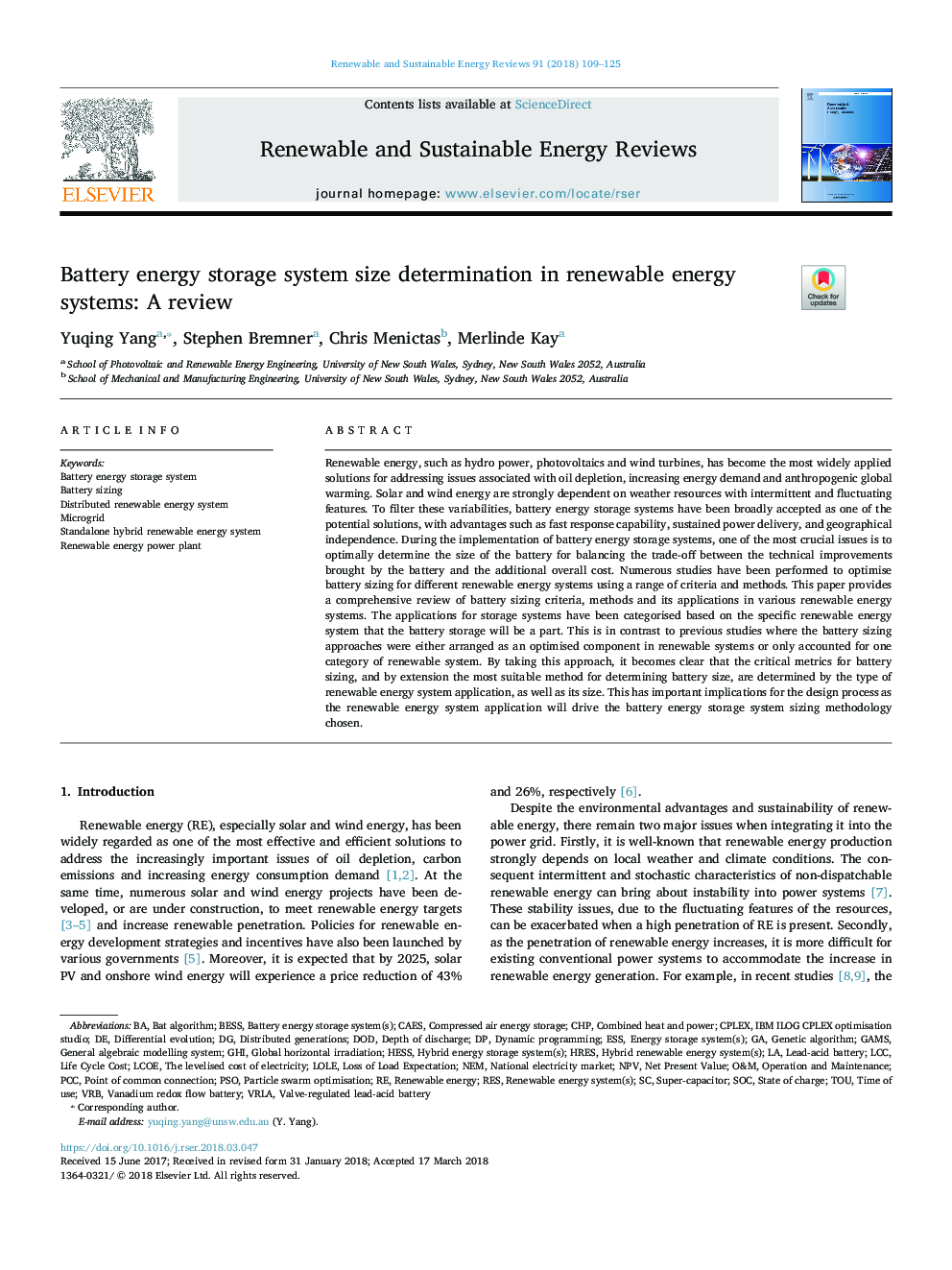| کد مقاله | کد نشریه | سال انتشار | مقاله انگلیسی | نسخه تمام متن |
|---|---|---|---|---|
| 8111034 | 1522293 | 2018 | 17 صفحه PDF | دانلود رایگان |
عنوان انگلیسی مقاله ISI
Battery energy storage system size determination in renewable energy systems: A review
ترجمه فارسی عنوان
اندازه سیستم ذخیره انرژی باتری در سیستم های انرژی تجدید پذیر: یک بررسی
دانلود مقاله + سفارش ترجمه
دانلود مقاله ISI انگلیسی
رایگان برای ایرانیان
کلمات کلیدی
VRLALCCCAESHREsRESESSVRBTOUDODPCCCPLEXNational Electricity MarketHESSLCOECHPO&M - A & MGAMs - GAM هاnet present value - ارزش خالص فعلیLoss of load expectation - از دست دادن انتظارات بارBAT algorithm - الگوریتم BATDifferential evolution - الگوریتم تکاملی تفاضلیGenetic algorithm - الگوریتم ژنتیکBattery sizing - اندازه باتریRenewable energy - انرژی تجدیدپذیرValve-regulated lead-acid battery - باتری اسید سرب تنظیم شده با شیرVanadium redox flow battery - باتری جریان ریودکس وانادیمLead-acid battery - باتری سربی - اسیدیDynamic programming - برنامهریزی پویا یا برنامه نویسی پویاPSO - بهینه سازی ازدحام ذراتparticle swarm optimisation - بهینه سازی ذرات ذراتBESS - بیسGlobal horizontal irradiation - تابش افقی جهانیCombined Heat and Power - ترکیب گرما و قدرتState of charge - دولت شارژCompressed air energy storage - ذخیره انرژی هوا فشردهMicrogrid - ریزشبکه Time of use - زمان استفادهSuper-capacitor - سوپر خازنBattery energy storage system - سیستم ذخیره انرژی باتریSOC - سیستم روی یک تراشهGeneral Algebraic Modelling System - سیستم مدل جبری جبریGHI - ضبطDepth of discharge - عمق تخلیهoperation and maintenance - عملیات و نگهداریNPV یا negative predictive value - مقادیر پیش بینی شده منفیDistributed generations - نسل توزیع شدهNEM - نهLife cycle cost - هزینه یابی چرخه عمر، هزینه چرخه زندگی
ترجمه چکیده
انرژی های تجدید پذیر مانند نیروگاه های آبی، فتوولتائیک و توربین های بادی، تبدیل به راه حل های به طور گسترده ای برای مقابله با مسائل مربوط به تخلیه نفت، افزایش تقاضای انرژی و گرم شدن زمین های انسانی شده اند. انرژی خورشیدی و باد به شدت وابسته به منابع آب و هوایی با ویژگی های متناوب و نوسان است. برای فیلتر کردن این متغیرها، سیستم های ذخیره انرژی باتری به عنوان یکی از راه حل های بالقوه پذیرفته شده اند و دارای مزایایی مانند قابلیت پاسخ سریع، تحویل قدرت و استقامت جغرافیایی می باشند. در طول اجرای سیستم های ذخیره انرژی باتری، یکی از مهم ترین مسائل این است که به طور مطلوب تعیین اندازه باتری برای تعادل تجارت بین بهبود فنی به دست آمده با باتری و هزینه کلی اضافی. مطالعات متعدد برای بهینه سازی اندازه باتری برای سیستم های مختلف انرژی تجدید پذیر با استفاده از طیف وسیعی از معیارها و روش ها انجام شده است. این مقاله یک بررسی جامع از معیارهای اندازه گیری باتری، روش ها و کاربردهای آن در سیستم های مختلف انرژی تجدید پذیر ارائه می دهد. برنامه های کاربردی برای سیستم های ذخیره سازی بر اساس سیستم انرژی تجدید پذیر اختصاص یافته است که ذخیره سازی باتری آن بخشی است. این در مقایسه با مطالعات قبلی است که در آن روشهای اندازه گیری باتری یا به عنوان جزء بهینه شده در سیستم های تجدید پذیر مرتب شده اند یا فقط به یک دسته از سیستم های تجدید پذیر اختصاص یافته است. با در نظر گرفتن این رویکرد، مشخص می شود که معیارهای بحرانی برای اندازه گیری باتری و گسترش روش مناسب برای تعیین اندازه باتری، بر اساس نوع سیستم انرژی تجدید پذیر و همچنین اندازه آن تعیین می شود. این امر پیامدهای مهمی برای فرآیند طراحی دارد، زیرا برنامه کاربردی سیستم انرژی تجدید پذیر، روش اندازه گیری سیستم ذخیره انرژی باتری را انتخاب می کند.
موضوعات مرتبط
مهندسی و علوم پایه
مهندسی انرژی
انرژی های تجدید پذیر، توسعه پایدار و محیط زیست
چکیده انگلیسی
Renewable energy, such as hydro power, photovoltaics and wind turbines, has become the most widely applied solutions for addressing issues associated with oil depletion, increasing energy demand and anthropogenic global warming. Solar and wind energy are strongly dependent on weather resources with intermittent and fluctuating features. To filter these variabilities, battery energy storage systems have been broadly accepted as one of the potential solutions, with advantages such as fast response capability, sustained power delivery, and geographical independence. During the implementation of battery energy storage systems, one of the most crucial issues is to optimally determine the size of the battery for balancing the trade-off between the technical improvements brought by the battery and the additional overall cost. Numerous studies have been performed to optimise battery sizing for different renewable energy systems using a range of criteria and methods. This paper provides a comprehensive review of battery sizing criteria, methods and its applications in various renewable energy systems. The applications for storage systems have been categorised based on the specific renewable energy system that the battery storage will be a part. This is in contrast to previous studies where the battery sizing approaches were either arranged as an optimised component in renewable systems or only accounted for one category of renewable system. By taking this approach, it becomes clear that the critical metrics for battery sizing, and by extension the most suitable method for determining battery size, are determined by the type of renewable energy system application, as well as its size. This has important implications for the design process as the renewable energy system application will drive the battery energy storage system sizing methodology chosen.
ناشر
Database: Elsevier - ScienceDirect (ساینس دایرکت)
Journal: Renewable and Sustainable Energy Reviews - Volume 91, August 2018, Pages 109-125
Journal: Renewable and Sustainable Energy Reviews - Volume 91, August 2018, Pages 109-125
نویسندگان
Yuqing Yang, Stephen Bremner, Chris Menictas, Merlinde Kay,
